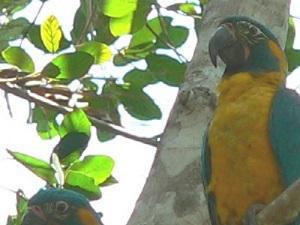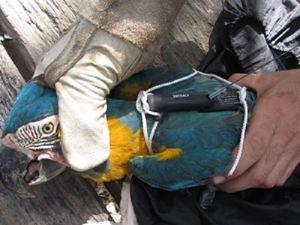Igor Berkunsky
Other projects
23 Sep 2008
Blue-Throated Macaw Conservation Project – Increasing the Availability of Nest Sites I
10 Sep 2009
Blue-Throated Macaw Conservation Project: Increasing the Availability of Nest Sites II
The aim of the project is to estimate population size and assess the actual distribution of macaws. We will model the distribution of suitable macaw habitat and potential future distribution. By identifying where suitable macaw habitat occurs it will be possible to focus conservation actions on areas that will allow the current population to expand both its size and range and allow essential connectivity between groups to maintain genetic viability of population.

This research will assess the occupied and unoccupied areas used by the macaws. The findings will determine where additional regions contain suitable macaw habitat to assist in the long-term conservation prospects of Blue-throated Macaws.

In our proposed efforts, field census and satellite radio collars will be used to assess the actual distribution and habitat use. Field data and satellite imagery will be used to model the distribution of suitable macaw habitat and identify areas for potential future distribution of the birds. By identifying where suitable macaw habitat occurs it will be possible to focus conservation actions on those areas and encourage the current population to expand both its size and range - thereby providing essential connectivity between groups to maintain genetic viability of the overall population.

The project will also investigate how local culture and economics impact the distribution of the macaws. This information will guide management strategies to reduce human impact on macaw’s habitat.
The main output of the project will be the development of a geographic information system, combining habitat use and availability with the macaw’s occupation and movements. The results will produce and test a predictive map of the bird’s distribution. These findings will provide essential information for conservation and land-use planning efforts to be used by governments, NGOs, and other organizations working to conserve the Blue-throated Macaws.
The achievement of following expected outputs from this project will have long lasting impact to conserve this endangered macaw. The proposed study will:
- Quantifying the species’ potential population.
- Establish the temporal and spatial distribution of Blue-throated Macaws.
- Provide baseline data on essential habitat hotspots needed for conservation priority and encourage land management in a sustainable way.
- Create findings will to be disseminated through publication in peer reviewed journals and to local and national level media to enhance awareness of the species’ plight.
- Act as a tool, through habitat mapping, for larger scale conservation planning and implementation of effective conservation measures.